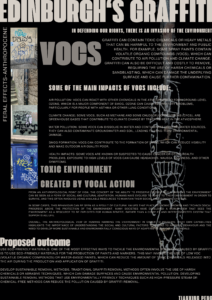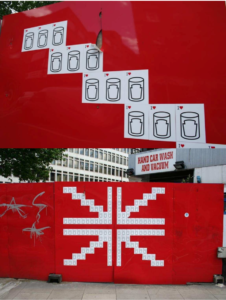Linda gave me some feedback after I presented this proposal on plant hunters (eucalyptus).
She raised confusion about my research; I had presented a lot of invasive literature on eucalyptus in the literature and sources, but the colonialism theory in it was not very clear, was it Extractive colonialism or something else? And I was never sure what identity I would end up in (artist, curator or what?). What kind of artistic activity will I do? Maybe it’s because I saw a related exhibition at the Botanic Gardens and had a good case study to refer to in front of me, leading me now to not be able to dig into something more meaningful based on that, so I started thinking about other directions.

In this paragraph, I decided to bring up the academic poster activity on graffiti from the Field Notes tutorial. I want to investigate in this class how to find a creative, sustainable, and more eco-friendly medium for creating and painting graffiti. As the development and expression of graffiti art reflect the social, political, economic, and cultural qualities and changes in many cultural contexts, this may be a new route for me. Graffiti art is also impacted by a variety of elements, including regional cultural traditions, morals, and creative styles. Therefore, a better comprehension and examination of local cultural and social phenomena may be reached by examining the cultural and historical background of graffiti art, so advancing anthropology and deepening cultural studies.
Gómez M A. The writing on our walls: Finding solutions through distinguishing graffiti art from graffiti vandalism[J]. U. Mich. JL Reform, 1992, 26: 633.
In this instance, I have learned about some new advancements in the field of graffiti, particularly in terms of study into how the pre- and post-graffiti eras changed through time.
Prior to the advent of graffiti, most graffiti art was produced by hand using relatively straightforward painting supplies like paint, spray paint, and chalk. Graffiti art evolved into a more uniform style during this time, mostly utilizing words, signs, basic patterns, and other elements.

Sticker Installation On Great Eastern Street,Convent Garden,London,2007,Author’s Photo

Space Invader,Convent Garden,London,2004,Author’s Photo
Graffiti art has steadily transitioned into the post-graffiti age. Graffiti production methods and techniques continue to innovate and alter as society and technology change. Modern graffiti artists create increasingly intricate, three-dimensional works of art using more advanced and high-tech painting instruments, such as spray painting machines and computerized drawing boards. Additionally, graffiti artists are experimenting with new forms of expression, such as three-dimensional graffiti, digital graffiti, and other forms of graffiti, by employing their imagination and ingenuity.
Dickens L. The geographies of post-graffiti: art worlds, cultural economy and the city[J]. Unpublished PhD thesis, Department of Geography, University of London, London, 2009.
Overall, the transition from the pre- to the post-graffiti eras illustrates how the methods and creative ideas used in graffiti art have undergone constant evolution. The nature and growth of graffiti art may be better understood, as well as the forms and meanings of graffiti art in various eras and cultural situations, by studying the history and development of graffiti art.
In order to have a good influence on the future of art and urban culture, I thus made the decision to investigate how modern computer art tools may be integrated with graffiti culture.
Reference list:
Gómez M A. The writing on our walls: Finding solutions through distinguishing graffiti art from graffiti vandalism[J]. U. Mich. JL Reform, 1992, 26: 633.
Dickens L. The geographies of post-graffiti: art worlds, cultural economy and the city[J]. Unpublished PhD thesis, Department of Geography, University of London, London, 2009.

